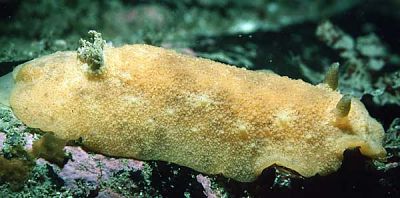
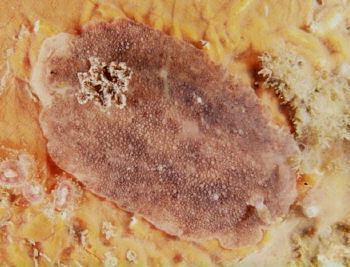
Geitodoris planata
(Alder & Hancock, 1846)
Order: NUDIBRANCHIA
Suborder: DORIDINA
Superfamily: EUDORIDOIDEA
Family: Dorididae
PHOTO
UPPER: Showing starlike (stellate) pattern of mantle glands - Rathlin O'Birne Is., Co Donegal, Ireland - April 1982. Photo: B.E. Picton.
LOWER: Bassin d'Arcachon, south-west Atlantic coast of France, near Bordeaux. Size 40 mm, depth 5 m, May 26, 1999. Photo: Michel Barrabés.
Characterised externally by a row of star-shaped whitish patches down each side of the mantle from behind the rhinophores to the gills.
Archidoris pseudoargus is often confused with another large dorid Geitodoris planata. As discussed below by a number of participants there are a number of distinguishing features. Unfortunately they are more apparent in the field than in photos. Geitodoris planata can be distinguished from Archidoris pseudoargus by the light coloured stellate patterns on the mantle (acid glands), and also by the more flattened shape. The underside of the animal is also important with Geitodoris planata having brown spots on the mantle, and conspicous oral tentacles, both characters lacking in Archidoris pseudoargus. In living animals there is a difference in texture, Geitodoris being crisper, harder and flatter.
Reference:
• Thompson, T.E. & Brown, G.H. (1976) Biology of Opisthobranch Moluscs. Vol 2. Ray Society: London.
• Cervera, J.L., Garcia-Gomez, J. & Garcia, F.J. (1985) Redescription of Geitodoris planata (Alder & Hancock, 1846). Journal of Molluscan Studies, 51: 198-204.
Rudman, W.B., 2000 (August 26) Geitodoris planata (Alder & Hancock, 1846). [In] Sea Slug Forum. Australian Museum, Sydney. Available from http://www.seaslugforum.net/find/geitplan
Related messages
Is it really Discodoris confusa ?
October 26, 2009
From: Alain-Pierre Sittler
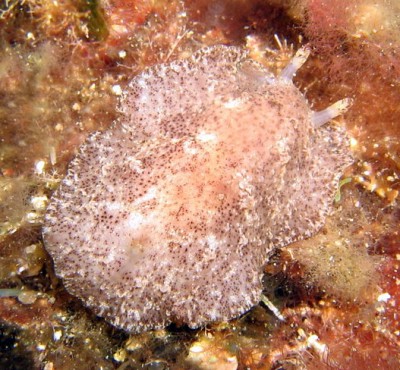
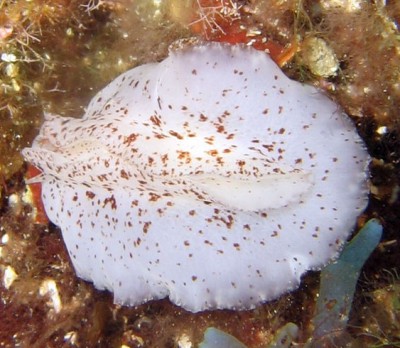
Dear Dr Rudman,
I found this species on a mediterranean wall, in the night. I identified it as Discodoris confusa but I have a doubt. It seems quite rare on our dive spots. Please, what do you think about ?
Locality: Pointe de la Cuisse, Rade de Villefranche-sur-Mer, 20 m, France, Mediterranean sea, 03 July 2008, Rocky wall with many Halimeda tuna. Photographer: Alain-Pierre Sittler.
Thank you very much
Alain-Pierre Sittler
APSittler@aol.com
Sittler, A.-P., 2009 (Oct 26) Is it really Discodoris confusa ?. [Message in] Sea Slug Forum. Australian Museum, Sydney. Available from http://www.seaslugforum.net/find/22717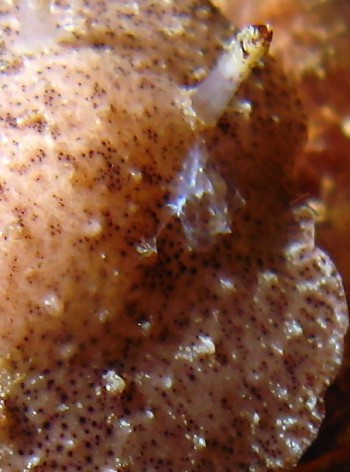
Dear Alain-Pierre,
The mantle skin certainly doesn't look like a species of Discodoris, and from your close-up photo we can see a whitish secretion exuding from one of the tubercles. This makes me wonder if it is a colour form of Geitodoris planata.
But these 'flat' dorids with brownish mottled colour patterns are very difficult to identify from photos. It needs someone with a good knowledge of their local fauna to help us out
Best wishes,
Bill Rudman
Re: Dorid from Slovenia [2]
October 16, 2009
From: Marina Poddubetskaia Ossokine
Concerning message #14872:
Dear Bill,
I agree with you : this dorid [message #14872[ looks exactly like Geitodoris planata. And the close-up shows the distinctive spots of this species.
Best regards,
Marina
nembro@yahoo.fr
Poddubetskaia Ossokine, M., 2009 (Oct 16) Re: Dorid from Slovenia [2]. [Message in] Sea Slug Forum. Australian Museum, Sydney. Available from http://www.seaslugforum.net/find/22698Dear Marina,
Thanks so much for helping clear up some of the 'unidentified'
Best wishes,
Bill Rudman
Adult Geitodoris planata
October 12, 2009
From: Marina Poddubetskaia Ossokine
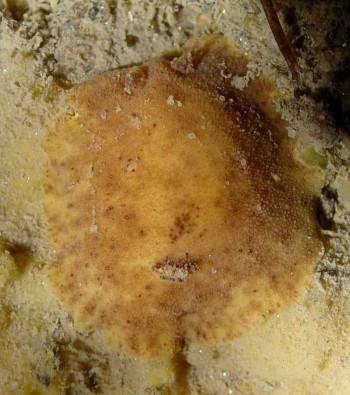
Concerning message #15692:
Bill,
To finish my series on Geitodoris planata [see messages #22693; #22694; #22695], here is a 33 mm long adult. It looks very like the dorid in message #16985, doesn't it ?
How you call it ? To close the circle ?
Locality: 'St-Yves', Arcachon, 13 m, France, Atlantic Ocean, 4 April 2006. Length: 33 mm. Photographer: Marina Poddubetskaia.
Best wishes,
Marina.
nembro@yahoo.fr
Poddubetskaia Ossokine, M., 2009 (Oct 12) Adult Geitodoris planata. [Message in] Sea Slug Forum. Australian Museum, Sydney. Available from http://www.seaslugforum.net/find/22696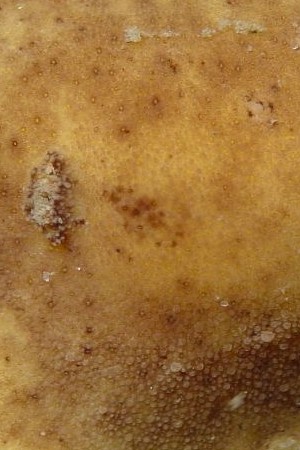
Thanks Marina,
Your photos have given us a valuable insight into variability in this species - as well as 'saving' a few messages from a longer stay in the 'unidentified files'
Best wishes,
Bill Rudman
Re: Geitodoris portmanni (?) from Sorrento
October 12, 2009
From: Marina Poddubetskaia Ossokine
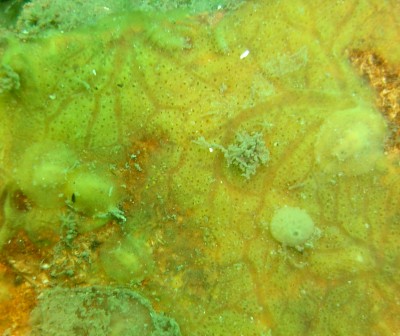
Concerning message #15692:
Dear Bill,
To continue my analysis of unidentified species, I agree with your ID of Fabio's dorid [message 15692] : it is probably a juvenile Geitodoris planata.
Several years ago, I discovered in Arcachon Bay small yellow dorids like this one, feeding on a yellow sponge. Initially, I was puzzled by their ID and supposed an unidentified species. But they were so numerous (each year I was seeing several dozens of it) and I concluded it could hardly be a rare or undescribed species. While observing them closely, with binocular, I noted a common characteristic with Geitodoris planata: small yellow spots ringed with brown, present in all the specimens ! That's how I arrived to the conclusion they were the juveniles of this very common species. Like adults, juveniles can have or not stellate pattern and acid glands. And their underside of the mantle can have dark spots or not.
Later, I saw subadults which seemed to confirm my ID.
The upper photo shows the juvenile aggregation on the yellow sponge.
Locality: 'Le Mimbeau', Cap Ferret, Arcachon Bay, 9 m, France, Atlantic Ocean, 14 August 2005. Length: 7-10 mm. Photographer: Marina Poddubetskaia.
The middle photos show the details of a juvenile with mantle underside view and characteristic yellow spots.
Locality: 'Le Mimbeau', Cap Ferret, Arcachon Bay, 9m, France, Atlantic Ocean, 14 August 2005. Length: 9 mm. Photographer: Marina Poddubetskaia.
The lower photo shows another juvenile, always with yellow spots.
Locality: 'Le Mimbeau', Cap Ferret, Arcachon Bay, 4m, France, Atlantic Ocean, 17 August 2005. Length: 10 mm. Photographer: Marina Poddubetskaia.
I will put other growing stages in a separate message.
Best wishes,
Marina.
nembro@yahoo.fr
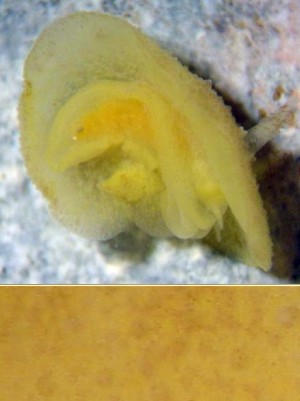
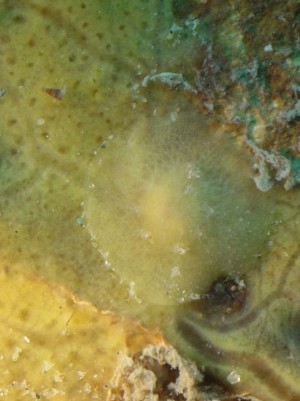
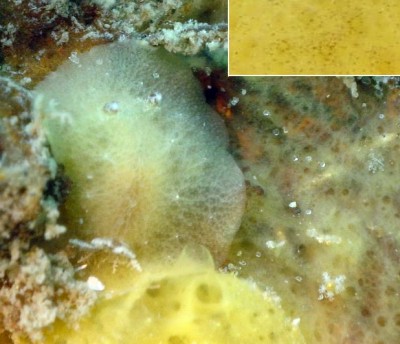
Dear Marina,
I was going to say when commenting on your other related messages, that these animals seem very well camouflaged on their sponge food. The brown rings which seem even more characteristic than the white stellate pattern around the acid glands, seem to mimic the large water current pores in the sponge colony. I know that saying such things is risky, as we don't really know what potential predators can see, but the size of the rings and their spacing is almost indentical to that of the sponge pores.
Best wishes,
Bill Rudman
Juvenile and subadult Geitodoris planata
October 12, 2009
From: Marina Poddubetskaia Ossokine
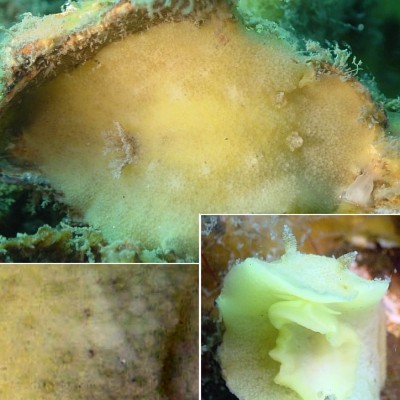
Concerning message #15692:
Bill,
To continue my previous message [#22693], here are other growth stages of Geitodoris planata:
The upper photo shows a 23 mm long subadult. It was found under the same rock and on the same sponge as the the 22 mm long specimen in the lower photo. They represent the extreme variation in this species :
- upper photo: presence of acid glands, no spots under the mantle
- lower: no acid glands (checked with binocular), with spots under the mantle
Locality: 'Hortense', Cap Ferret, Arcachon Bay, 5 m, France, Atlantic Ocean, 10 October 2009. Length: 23 mm + 22mm. Photographer: Marina Poddubetskaia.
The middle photos show two 30 mm long subadults with the beginning of brown coloration.
Locality: 'Grand Piquey', Cap Ferret, Arcachon Bay, 2 m, France, Atlantic Ocean, 14 September 2005. Length: 30 mm. Photographer: Marina Poddubetskaia.
Best wishes,
Marina.
nembro@yahoo.fr
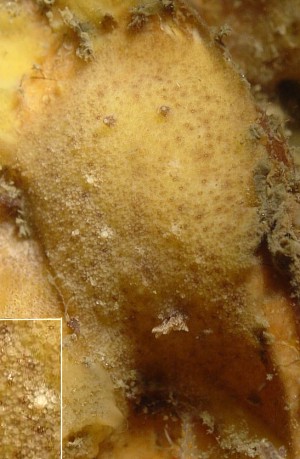
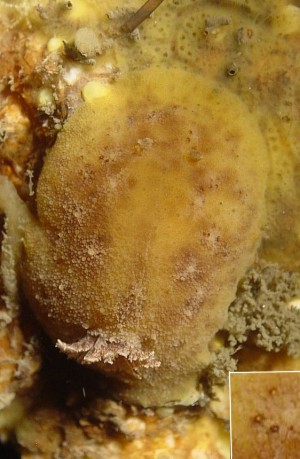
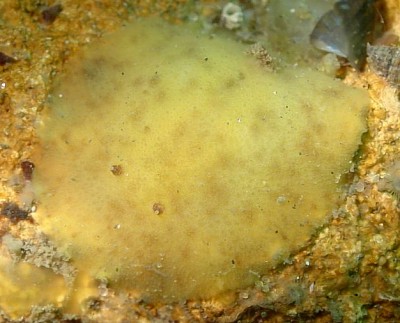
Dear Marina,
Thanks for more photos showing the variability found in this common species. A range of photos like this makes it much easier to show how the colour pattern of one animal is linked to that of another. I think we can be fakry confident that Fabio's animal is a juvenile of this species.
Best wishes,
Bill Rudman
Re: Unknown Dorid from Italy
October 12, 2009
From: Marina Poddubetskaia Ossokine
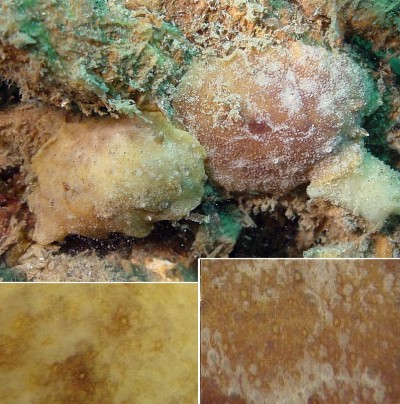
Concerning message #16985:
Dear Bill,
I can't identify the dorid in Dominique's message [#22563], but I think I can help with some other unidentified ones. To start, I think the dorid in message #16985 is Geitodoris planata.
Geitodoris planata is probably the most common nudibranch of Arcachon Bay, I saw so many of it. It is very variable in colour (creamy white, yellow, pale and dark brown) and in 'granularity' (low or obvious tubercles, with or without stellate pattern and acid glands). The underside of the mantle can have dark spots or not, at least some spots aren't visible with naked eye.
But all the Geitodoris planata have small yellow spots ringed in brown, like in this animal. Usually, these spots are hardly visible in field photos, but always present if you check it with binocular microscope. I have included close-ups in the upper photo showing yellow and brown colour forms.
The middle photo shows an animal with only one acid gland but yellow spots visible in field. I haven't seen these spots in other similar dorids. And the egg-mass of Cristian's message fits this species.
To complete the colour variation in G. planata, the lower photo shows the creamy white colour form.
Upper Photo: Locality: 'Le Mimbeau', Cap Ferret, Arcachon Bay, 7 m, France, Atlantic Ocean, 8 May 2006. Length: yellow 20mm + brown 27 mm. Photographer: Marina Poddubetskaia.
Middle Photo: Locality: 'St-Yves', Arcachon, 12 m, France, Atlantic Ocean, 29 June 2005. Length: 35 mm. Photographer: Marina Poddubetskaia.
Lower Photo: Locality: 'Le Mimbeau', Cap Ferret, Arcachon Bay, 7 m, France, Atlantic Ocean, 8 May 2006. Length: 43 mm. Photographer: Marina Poddubetskaia.
Best wishes,
Marina.
nembro@yahoo.fr
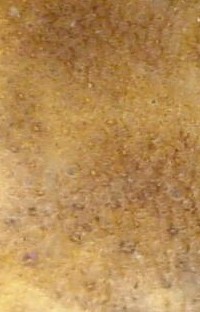
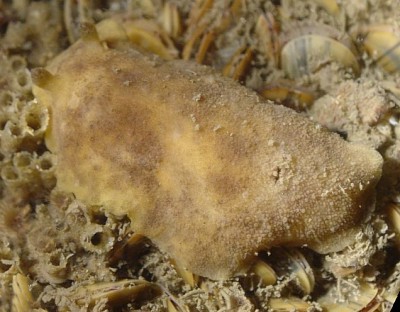
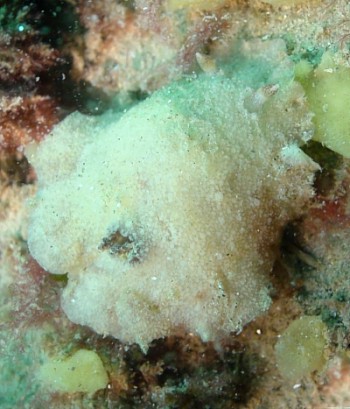
Dear Marina,
Thanks very much for these photos showing variation in the species and identifying Cristian's animal. Finding someone who knows a local fauna well is usually the best way to resolve these identification puzzles. Most books emphasise the white stellate pattern around the acid glands which as you show is not very useful for animals which lack the pattern
Best wishes,
Bill Rudman
Unknown Dorid from Italy
May 31, 2007
From: Cristian Magnani
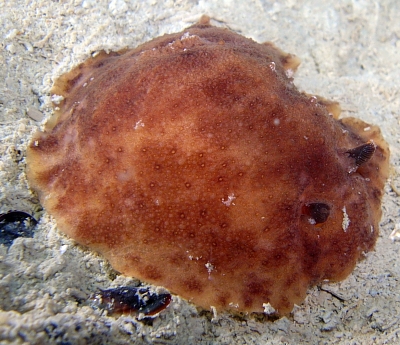
Note added 12 October 2009: This has been identified as Geitodoris planata - see message #22693.
Dear Bill
The identification of this dorid has been puzzling me during the last two weeks. Even though it looks quite like Archidoris pseudoargus its egg coil looks pretty different as you may see from the attached picture. In my opinion they look like the ones from Platydoris argo but the slug is quite different. Its foot was cream yellow with no patches or spots so it is not Geitodoris planata (it also lacks white acid tubercles on the dorsum)...
I wish to know your idea about this little animal.
Locality: Numana, 13, Italy, Adriatic Sea, 10 June 2006, Shipwreck. Length: 35 mm. Photographer: Cristian Magnani.
Thanks in advance.
Best wishes
Cristian
info@nudibranchi.it
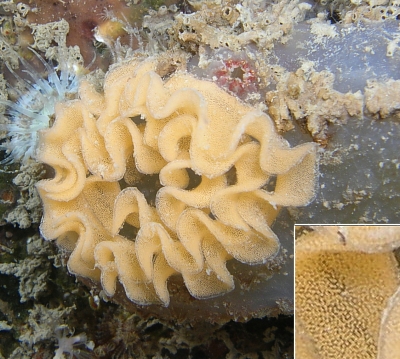
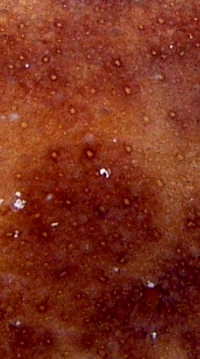
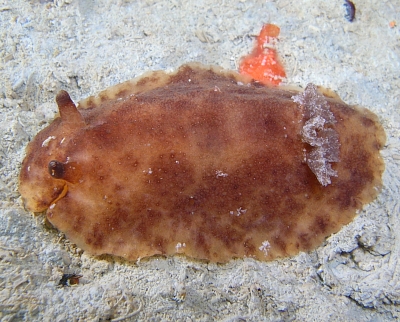
Dear Cristian,
I haven't had any success in getting this identified. Hopefully someone will be able to help.
Best wishes,
Bill Rudman
Geitodoris portmanni (?) from Sorrento
February 6, 2006
From: Fabio Russo
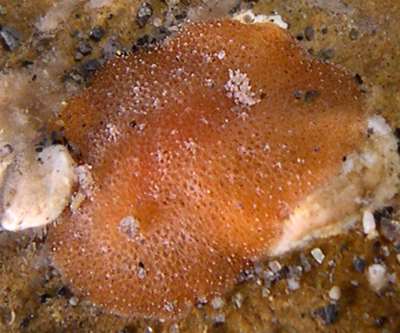
Note added 12 October 2009: This has been identified as Geitodoris planata - see messages #22694, #22695.
Dear Bill,
I took this shot of a dorid in a night dive in Sorrento (Naples), i found it under a stone! I think it is Geitodoris portmanni, but i'm not sure!
It has white rhinophores and gills, but i can't see the darker area on the dorsal surface!!!
Locality: Punta Circe, Sorrento (Naples), Italy. Tirrenian Sea. Depth: 6 meters. Length: 10 mm. 15 December 2005. Muddy. Photographer: Fabio Russo
Fabio Russo
scercola@alice.it
Russo, F., 2006 (Feb 6) Geitodoris portmanni (?) from Sorrento. [Message in] Sea Slug Forum. Australian Museum, Sydney. Available from http://www.seaslugforum.net/find/15692Dear Fabio,
It reminds me of Geitodoris planata but some of these dorids are difficult to identify from photographs even for prople with with local knowledge of the fauna. Let's hope that someone with a personal knowledge of the Mediterranean fauna can help us.
Best wishes,
Bill Rudman
Dorid from Slovenia [2]
October 1, 2005
From: Tom Turk
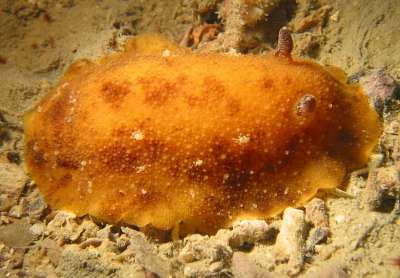
Dear Bill,
Here is another dorid from Slovenia. The picture was taken in front of Marine Biological Station in Piran, Slovenia. I think it is Archidoris pseudoargus.
Locality: Piran, Slovenia, Adriatic Sea. Depth: few meters. Spring 2005. muddy, some rocks and algae. Photographer: Tihomir Makovec
Best regards,
Tom Turk
tom.turk@bf.uni-lj.si
Turk, T., 2005 (Oct 1) Dorid from Slovenia [2]. [Message in] Sea Slug Forum. Australian Museum, Sydney. Available from http://www.seaslugforum.net/find/14872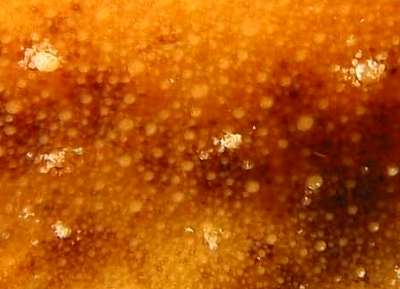
Note added 16 October 2009: see message #22698 agreeing with my identfiication..
Dear Tom,
My guess, from the large mantle tuberculate mantle glands, is that this is Geitodoris planata. However I would like some confirmation, or comments, from local experts
Best wishes,
Bill Rudman
Re: Geitodoris planata from Devon, UK.
August 27, 2005
From: Judith Oakley
Bill,
Re message [#14437] please can you tell me the reference re: the change in name so I can amend my information.
Thank you.
Judith Oakley
kf1@mba.ac.uk
Oakley, J.A., 2005 (Aug 27) Re: Geitodoris planata from Devon, UK.. [Message in] Sea Slug Forum. Australian Museum, Sydney. Available from http://www.seaslugforum.net/find/14639Dear Judith,
Where necessary I am fairly diligent at adding references to messages but I expect a bit of 'self help' as well. First stop should be the Fact Sheet - where, as in this case, there is a relevant reference. Secondly, have a look at the related messages at the end of each Fact Sheet. In an ideal world I would have a team of slaves making sure all the new information added each day to the Forum was collated and summarised and added to the relevant Fact Sheets but as I don't I prefer to spend my time answering and commenting on new messages. You can also use material on the Forum as a reference. That is why I add a standard citation at the end of every contribution to the Forum. A considerable proportion of opisthobranch papers published today include citations to material in the Forum
Best wishes,
Bill Rudman
Geitodoris planata from Devon, UK.
August 23, 2005
From: Judith Oakley
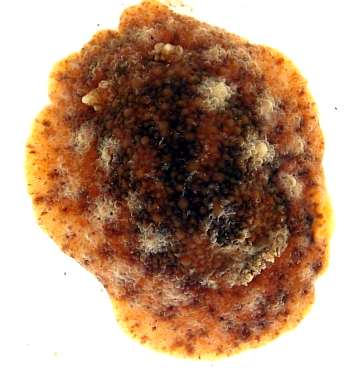
Can you confirm that this is Discodoris planata.
Locality: Goodrington Sands, Torbay, Devon, UK. Length: 32 mm. 4 July 2005. intertidal in crevice. Photographer: Judith Oakley
Judith Oakley
kf1@mba.ac.uk
Oakley, J.A., 2005 (Aug 23) Geitodoris planata from Devon, UK.. [Message in] Sea Slug Forum. Australian Museum, Sydney. Available from http://www.seaslugforum.net/find/14437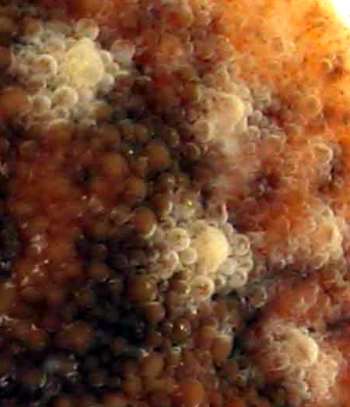
Dear Judith,
I am pretty sure your indentification is correct, although it is now considered to be in the genus Geitodoris rather than Discodoris. One way to distinguish from other tuberculate dorids in your area is to look for the the slightly larger and raised acid glands which consist of a larger central tubercle surrounded by a ring of smaller tubercles. The tubercles are white or whitish and often there is a pattern of white streaks radiating out from the central tubercle.
Best wishes,
Bill Rudman
Geitodoris planata - mating
May 24, 2005
From: Philipp Kauffmann
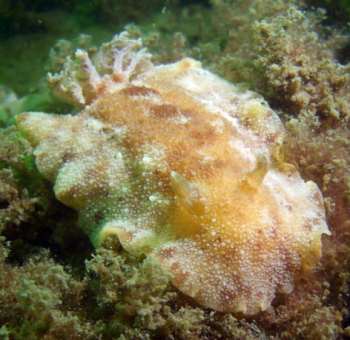
Hello everybody,
The first picture shows a single Geitodoris planata. Is she feeding?
The other two pictures show two Geitodoris planata. WE watched them for about 5 minutse and they didn't move. Are they pairing? If yes how do they do it? Both animals have different colours. Is it because of their different sex?
Locality: Grevelingen Meer, Netherlands. Depth: 10 m. Length: 8-10 cm. 15 May 2005. Photographer: Philipp Kauffmann
Thanks a lot!
Philipp
philipp@dive2paradise.de
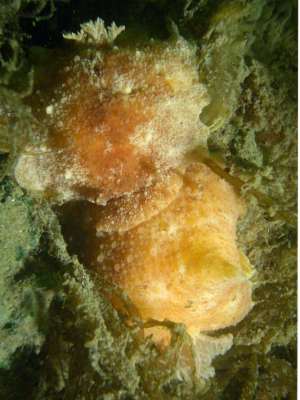
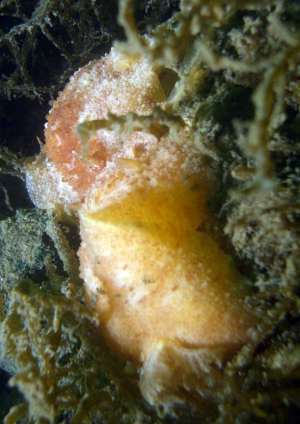
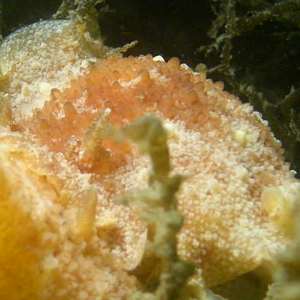
Dear Philipp,
It's hard to know whether or not the animal is feeding because their mouth is hidden under the mantle skirt. It could be the animal is just crawling around, or perhaps having a rest. Most of these big flat dorid nudibranchs are sponge feeders, but unless we actually catch them feeding, we have to be very cautious when we find one on a sponge. It could be its food, or it could just be something it is crawling over.
As I said in answer to your other message [#13822], all nudibranch are hermaphrodite so there are obviously no sexual differences in colour, size or shape. The colour differences are just part of the natural colour variation we find in many species. I have inclused a close-up of the mantle alongside as it shows the tubercles rather well.
Best wishes,
Bill Rudman
Geitodoris planata research
March 4, 2004
From: Thierry Backeljau
Dear All,
Request for specimens:
In the context of a licence degree work, a student of mine is screening DNA variation in Geitodoris planata in the Eastern Scheldt Estuary (The Netherlands), where this species has been introduced since 1999. For comparative purposes we need conspecific material for from other regions, as well as of related species (Geitodoris spp. and even other Discodoridae). Therefore my request for help. I would indeed be very grateful for any material of this sort that can be provided. Specimens do not need special conservation, they only have to be fixed in ethanol of 70% to 96%. Specimens will be returned afterwards (we only need a small piece of tissue to extract DNA). If possible several specimens (5-20) per population would be most convenient in case of G. planata, while for other species 1-5 specimens would suffice. If you would be able and willing to help us with such material, please contact me in advance.
THANK YOU VERY MUCH IN ADVANCE!!
Very best wishes,
Thierry Backeljau
Royal Belgian Institute of Natural Sciences
Fax: +32.2.627.41.41
Tel: +32.2.627.43.39
Thierry.Backeljau@naturalsciences.be
Backeljau, T., 2004 (Mar 4) Geitodoris planata research. [Message in] Sea Slug Forum. Australian Museum, Sydney. Available from http://www.seaslugforum.net/find/12352Anyone wishing to help should contact Thierry wpu;d
Geitodoris planata research project
September 4, 2003
From: Peter H. van Bragt
Hello Bill and all forum readers and participants.
As mentioned in an eartlier message, there has been a recent and remarkable introduction of Geitodoris planata in the Dutch coastal waters. Together with a Belgium research group, we are initiating a research project, based on DNA typing, on this species. For this project we have collected specimens from the Dutch coast, and we are now urgently looking for reference material from all over the European coast and if possible from beyond the European coast too.
Therefore I would like to post the following request: We would like to get in touch with as many sports divers and marine biologists who could help us with collecting Geitodoris planata specimens. You may contact me by e-mail [address below] for further details.
When this project comes to publishable results we will ofcourse aknowledge all support in the relevant publications and publish a summary of results on the Sea Slug Forum.
Best regards and thank you all in advance for your help,
Peter H. van Bragt
vanbragt.phjm@hsbrabant.nl
van Bragt, P.H., 2003 (Sep 4) Geitodoris planata research project. [Message in] Sea Slug Forum. Australian Museum, Sydney. Available from http://www.seaslugforum.net/find/10885Good Luck Peter,
Look forward to hearing of your results
Bill Rudman
Geitodoris planata from French Atlantic [1]
July 10, 2003
From: Marina Poddubetskaia
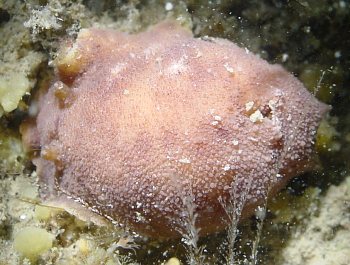
Dear Bill,
I found this starry dorid in Bassin d'Arcachon. I think it is Geitodoris planata. Could you confirm this ID, please?
I found several white egg-ribbons nearby photos of which I have sent in an accompanying message.
I know another dorid which looks like this one: Discodoris stellifera. How these species could be distinguished?
Date: May 09, 2003
Location: Bassin d'Arcachon, France, Atlantic coast
Site: Le Roche Velaine wreck
Depth: 13m
Size: 35-40mm
Photos: Marina Poddubetskaia - Nembro website
Best wishes,
Marina.
nembro@nembro.info
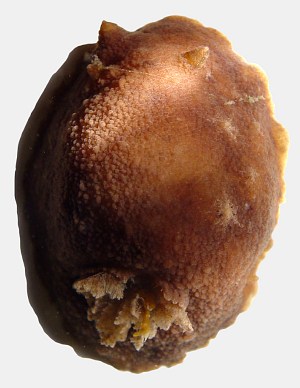
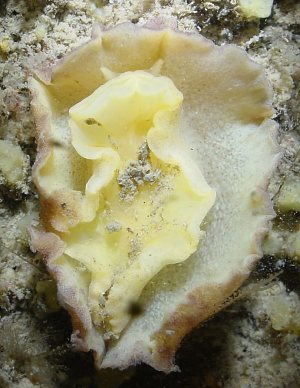
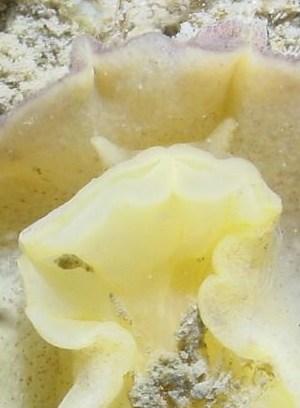
Thanks Marina,
This is most probably Geitodoris planata. Discodoris stellifera is very similar externally and according to
Lucas Cervera's message, it may be necessary to have a look at their radular teeth to be sure - not a very good strategy for an ecologist to follow. Perhaps someone can give us a suggestion on how to distinguish these two species externally
Best wishes,
Bill
Geitodoris planata from French Atlantic [2]
July 10, 2003
From: Marina Poddubetskaia

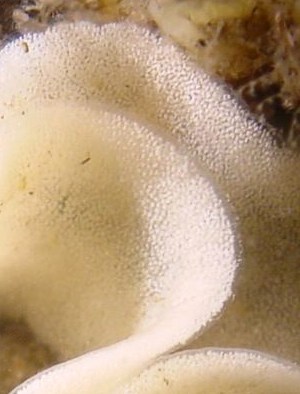
Dear Bill,
I found several white egg-ribbons, like in photo, near the Geitodoris planata in my accompanying message. I'm not sure it belongs to this animal, but it looks like the eggs of Geitodoris planata I have seen before.
Date: May 09, 2003
Location: Bassin d'Arcachon, France, Atlantic coast
Site: Le Roche Velaine wreck
Depth: 13m
Photos: Marina Poddubetskaia - Nembro website
Best wishes,
Marina.
nembro@nembro.info
Poddubetskaia, M., 2003 (Jul 10) Geitodoris planata from French Atlantic [2]. [Message in] Sea Slug Forum. Australian Museum, Sydney. Available from http://www.seaslugforum.net/find/9977Thanks Marina,
Bill Rudman
Geitodoris planata from the Netherlands
July 9, 2003
From: Claire van Groningen
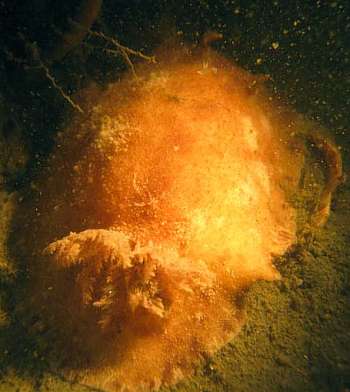
Being new to diving and to underwater photography I am trying to id a sea slug we encountered on the 21st of June in the Grevelingenmeer in the Netherlands. It must have been at least 10cm long, and was at a depth of 15m.
Grevelingen Meer, Den Osse Haven, Zeeland, the Netherlands. This is a brackish lake north of the Oosterschelde. 21 June 2003
I believe it is a Geitodoris planata but maybe someone can help me be sure.
Thank you.
Claire
ladybug@xs4all.nl
Groningen, C., 2003 (Jul 9) Geitodoris planata from the Netherlands. [Message in] Sea Slug Forum. Australian Museum, Sydney. Available from http://www.seaslugforum.net/find/10334Dear Claire,
One good way to identify Geitodoris planata externally is the stellate [starlike] pattern radiating out from each of the raised papillae on the mantle. Although not very lear in your photo I am prety sure can see that feature on your photo. Anyway you can rest assured that if I have got it wrong someone in Europe with a better knowledge of your fauna will let us know
Best wishes
Bill Rudman
First sighting of Geitodoris on Helgoland, North Sea
April 16, 2003
From: Philipp Schubert
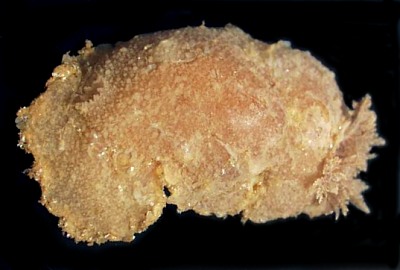
Dear Bill,
I just wanted to let you know that we found the first Geitodoris planata on Helgoland in the German Bight, North Sea. The individual was found last summer (2002) while diving in a sheltered harbour ("Südhafen") on a wall with diverse sponges, laying egg ribbons. I wrote my masters-thesis about Nudibranchs on Helgoland (and their interactions with bryozoans, actually) and found this big opisthobranch incidentially while searching for other slugs. It has never been found on this Island before, although it could possibly have been confused with Archidoris pseudoargus, which is quite common here.
With the background of an "explosion" of Geitodoris last summer in the Oostershelde, it is possible that this is a sign for a gradual advance of this species in the North Sea, where it was missing before, if we believe the literature (Thompson & Brown, 1984; Thompson, 1988; Picton & Morrow, 1994).
Sorry that I passed this information on to you so late, but first I thought it was nothing special...
The upper photo was taken in the aquarium from above [All photos were taken by Heidi Zanker]. The star-shaped glands are not quite good visible, but were present.
The lower left illustration is copied out of Thompson & Brown (1984), showing the differences between A Archidoris pseudoargus, and B Geitodoris planata. The lower right photo of the oral region was taken in an aquarium to prove, that this is in fact Geitodoris and not Archidoris.
I really like your site and think it´s a very good possibility to get actual informations about Nudibranchs, so keep on rocking!! In future maybe I´ll try to add some Nudis from Kiel/Baltic Sea, this part of of the world's oceans is still under-represented in your forum, put in fact we have some nice species here, too.
So long,
Philipp Schubert
derschubi@web.de
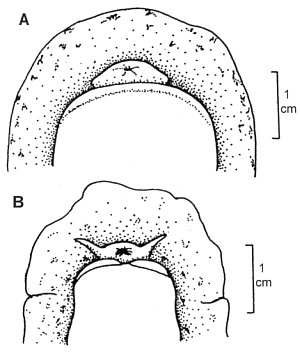
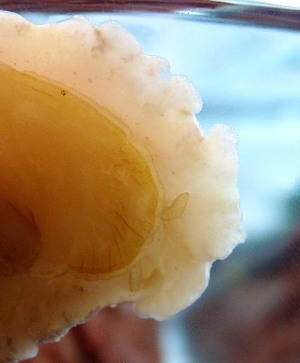
Thanks Philipp,
An interesting find. It's often difficult to know whether a 'new record' means an animal has just arrived or whether it means a human who can identify it accurately has just arrived. I guess that's why Picton & Morrow say 'No records exist for the North Sea coasts', meaning no-one has recorded it from there rather than it doesn't live there.
Whatever the reason, it is good to get new information on even the most common species. I hope you will be publishing information from your masters-thesis and will look forward to seeing it. I also hope you will send us some information on the Kiel/Baltic Sea fauna.
Best wishes,
Bill Rudman
Re: Geitodoris planata
June 17, 2002
From: Jean-Pierre Bielecki
Hi Bill
Thank you very much to Lucas, Peter and you Bill for helping me to the ID of this dorid (Geitodoris planata?). The locality you added is correct. This dive site in the "lagoon" of Thau is always the same small place, may be 100 square meter. I try to spend 6-10 hours under water by month because it is a little far from my home (350km), but it is the first time I saw this species or the eggs during 2 years of exploration here. The biodiversity in this place is very important and specific. The sponges are abundant and in fact I suspect a Mycale species to be near the place I found the dorid. Next time I will try to collect a peace of sponge to Peter.
To come back to our dorid, I am almost certain to have seen the characteristic oral tentacles on the underside of the animal and the texture was like you describe for the Geitodoris planata : crisp, hard and very flat.
Regards,
Jean-Pierre
bielecki.jeanpierre@free.fr
Bielecki, J-P. , 2002 (Jun 17) Re: Geitodoris planata. [Message in] Sea Slug Forum. Australian Museum, Sydney. Available from http://www.seaslugforum.net/find/7273Re: Geitodoris planata? from Mediterranean
June 15, 2002
From: Juan Lucas Cervera
Hi Bill,
If this animal is from the Mediterranean, it could be possible that it was Discodoris (= Anisodoris) stellifera which is also characterised by "stars" formations on the back. The radula is a good way to distinguish D. stellifera from Geitodoris planata.
See the following papers for more information.
• Ortea, J.A. (1990) El genero Geitodoris Bergh, 1891 (Mollusca: Nudibranchia) en las Islas Canarias. Rev. Acad. Canar. Cienc., 2: 99-120.
• Cervera, J.L., Garcia-Gomez, J.C. & Garcia, F.J. (1985) Redescription of Geitodoris planata (Alder & Hancock, 1846) (Gastropoda: Nudibranchia). J. Moll. Stud., 51: 198-204.
Regards.
Lucas.
lucas.cervera@uca.es
Cervera, J.L., 2002 (Jun 15) Re: Geitodoris planata? from Mediterranean. [Message in] Sea Slug Forum. Australian Museum, Sydney. Available from http://www.seaslugforum.net/find/7264Thanks Lucas.
Nothing is ever simple. Is there no good external characters? I wondered about Discodoris stellifera but the apparent size of the tubercles on the mantle in Jean-Pierre's photo seemed a bit large for a species of Discodoris. But there is no way I can definitively identify it so any more comments from anyone familiar with these two species would be very welcome
Bill Rudman
Re: Geitodoris planata? from Mediterranean
June 15, 2002
From: Peter H. van Bragt
This animal does indeed looks like G. planata. The tubercules, starshaped white structure around the tubercules, the gills and the rhinophores are very much like the ones we find in the Netherlands. The egg spiral is here mostly pure white or just slightly yellowish, but never as dark as on these pictures. And the animal itself is also much darker than the ones we find. This could be because of its choice for food (specific sponge). In the Netherlands G. planata feeds on a different species of Mycale than as it does on the Atlantic coast. Maybe this one feeds on yet another species of Mycale in the Mediterranean sea. If you find one again, please try to collect a specimen of the sponge. I would gladly try to assist in finding out what species it is.
With Dutch greetings
Peter H. van Bragt
vanbragt.phjm@hsbrabant.nl
van Bragt, P.H., 2002 (Jun 15) Re: Geitodoris planata? from Mediterranean. [Message in] Sea Slug Forum. Australian Museum, Sydney. Available from http://www.seaslugforum.net/find/7265Thanks Peter,
Bill Rudman
Geitodoris planata? from Mediterranean
June 14, 2002
From: Jean-Pierre Bielecki
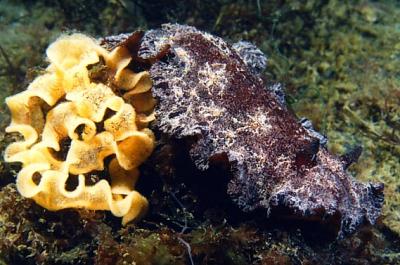
Hi Bill
Could you help me to ID this big Doris about 10cm long. The eggs and the flat body are similar with Platydoris argo but the colour pattern and the tubercles on the mantle are very different.
[found on the Mediterranean coast of France in May 2002. Dive site: Sète, étang de Thau.]
Best regards.
Jean-Pierre Bielecki
bielecki.jeanpierre@free.fr
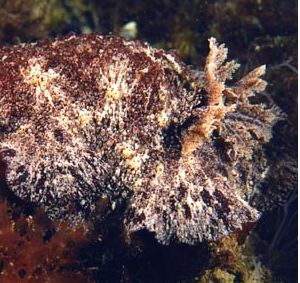
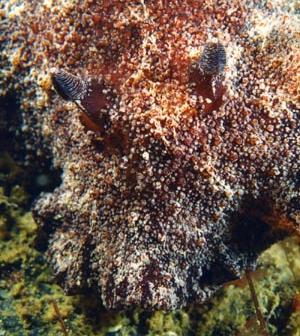
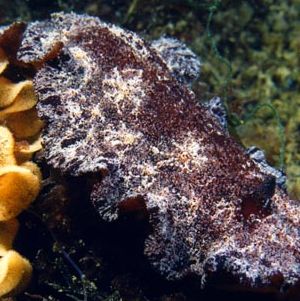
Dear Jean-Pierre,
At the risk of being quite wrong I would suspect your animal is Geitodoris planata which is characterised externally by the white stellate [star-like] marks on each side of the mantle. They seem to be prominent in your animal than in otjer photos I have seen but I think they are fairly unique to this species. I am sure someone will let us know if I am wrong.
NOTE: Is the locality I added correct? It was absent from your message so I took this from your other messages.
Best wishes,
Bill Rudman
Re: Food of Dutch Geitodoris planata
September 2, 2001
From: Albert Koulman
Concerning the continuing discussion on the food of Geitodoris planata in the Netherlands, I do not think that Geitodoris planata will have big impact on the population of Mycale micracanthoxea. One has to take into account that the Oosterschelde is an artificial controlled ecosystem. Especially the areas with rocky substrates, these are all part of the Deltaworks to protect the Southwest of the Netherlands against the sea. There is an open connection between the Oosterschelde and the North Sea but the entrance is much smaller than it used to be and it can be closed when the water rises too much during gales. The introduction of rocky shores in the Oosterschelde has resulted in the introduction of many species. This is one of the reasons that almost every year a nudibranch species is found that was not previously reported from the Netherlands. There are for instance several places in the Oosterschelde where you can find large amounts of Electra pilosa, however nudibranchs that eat this bryozoa are very rare. We have had huge amounts of Elysia viridis in the Oosterschelde, and there were years that you could see over a hundred specimens of Janolus cristata in one dive, while the next year it would take 10 dives just to see one specimen, even though there is usually enough Bugula. The Oosterschelde is not a balanced ecosystem (yet). Maybe we can report next year the sighting of Aegires punctilucens, we have more the enough Leucosolenia here.
Still we have had no nudibranch in the Oosterschelde that had a real impact. Maybe for one year, but due to large temperature variations of the Oosterschelde (it is now 22 degrees Celsius and it will go down to 4 or less in the winter) they will disappear again. We have to wait until some new larvae will find there way into the Oosterschelde.
Albert Koulman
A.Koulman@farm.rug.nl
Koulman, A., 2001 (Sep 2) Re: Food of Dutch Geitodoris planata. [Message in] Sea Slug Forum. Australian Museum, Sydney. Available from http://www.seaslugforum.net/find/5198Dear Albert,
Thanks for this interesting description of the Oosterschelde habitat. I think the point that was being made was not that Geitodoris would affect the population of the sponge, but that the presence of the sponge was perhaps the reason Geitodoris was suddenly so abundant in the Oosterschelde. It is interesting that some of the other examples you mention are feeders on bryozoan species which are common fouling organisms which rapidly colonise spaces which become available. The nudibranchs that feed on these colonisers are equally opportunistic, with life cycles which have evolved to survive these conditions. They have very short life spans, needing to grow to maturity and breed, before the short-lived bryozoan colony on which they are living and feeding dies. They are often found in large short-lived populations.
This is not normally the lifecycle of a large sponge-feeding dorid like Geitodoris which again suggests that not only is the environment artificial, but the abundance of the sponge may also be unusual. Elsewhere in the world when a 'foreign' marine organism is introduced to a country, it often rapidly produces a dense population close to its point of introduction before beginning to spread more widely. Which sounds much like the situation with Mycale micracanthoxea and certainly makes Bernard Picton's suggestion that perhaps this new species of sponge is a recent arrival in Europe an idea worth considering.
A very interesting situation,
Best wishes,
Bill Rudman
Food of Dutch Geitodoris planata
August 30, 2001
From: Peter H. van Bragt
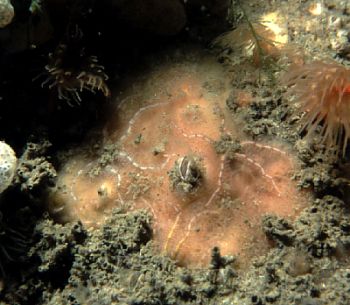
Hello Bill
Yesterday I received the final determination of the sponge on which our local Geitodoris planata feeds. Rob van Soest confirmed that it is Mycale micracanthoxea Buizer & Van Soest, 1977.
As I mentioned before almost all G. planata are found between 2 and 12 meters. This is in line with the local distribution of this sponge which was until now not found below 10 m. in the Dutch coastal waters. However last week I found one specimen at 15 m. and another one at almost 21 m. depth. Both were also feeding on a similar sponge; pale yellow, very thin encrusting on oysters. I assume this is also the same Mycale. With this observation the presence of this nudibranchs helps us also with extending our knowledge on the distribution of a sponge in the Netherlands.
With best regards and dutch greetings
Peter
vanbragt.phjm@hsbrabant.nl
van Bragt, P.H., 2001 (Aug 30) Food of Dutch Geitodoris planata. [Message in] Sea Slug Forum. Australian Museum, Sydney. Available from http://www.seaslugforum.net/find/5170Thanks Peter,
Bill Rudman
Re: Food of Dutch Geitodoris planata
August 30, 2001
From: Bernard Picton
Hi Bill,
I see you recently posted Peter van Bragt's pictures of Geitodoris planata. He emailed me to say that Rob van Soest had identified the food as Mycale micracanthoxea (see separate message). Rob is a top world sponge expert)
Now it is very interesting that this sponge appears to occur primarily in the Oosterschelde and to be very common there. It was first found in the neighbouring Westerschelde in 1953 and van Soest also had a Vosmaer specimen from Bergen op Zoom which was undated. van Soest says in his 1976 paper that the sponge is exclusively known from Dutch waters.
I wonder if we are seeing here an introduced species of sponge - therefore vulnerable to the (Mycale eating) Geitodoris, which has now found the sponge and will have a big impact on its populations?
Bernard
bernard.picton.um@nics.gov.uk
Picton, B.E., 2001 (Aug 30) Re: Food of Dutch Geitodoris planata. [Message in] Sea Slug Forum. Australian Museum, Sydney. Available from http://www.seaslugforum.net/find/5171Thanks Bernard,
It's very interesting idea. Introduced 'foods' can certainly introduce strange events in local ecosystems. I have mentioned an example in New Zealand, elsewhere in the Forum concerning Rostanga muscula. A feeding study by Ayling (1968) showed that in Auckland three poecilosclerid sponges were eaten by this species and there was a clear order of preference. Interestingly, its second favourite food was later discovered to be Clathria seriata, an introduced species from Europe which disappeared after a brief period of 3 years.
If, as you suggest, Mycale micracanthoxea does turn out to be an introduced species which Geitodoris planata has found particularly tasty, it would explain the unusual population explosion of this species in the Netherlands.
Best wishes,
Bill Rudman.
Geitodoris planata - population explosion in Holland
August 22, 2001
From: Peter van Bragt
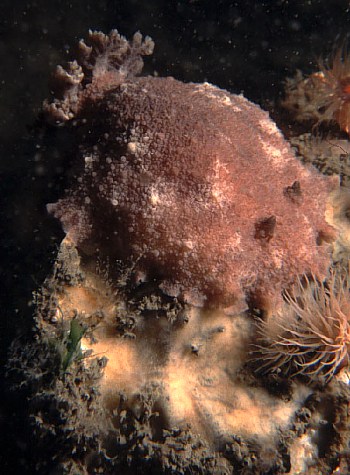
At this moment (summer 2001) we are experiencing a remarkable explosion of Geitodoris planata in the Oosterschelde Bay, in the southwest of the Netherlands. The first specimen recorded from the Netherlands was found in June 1999. Now (July 2001) it is not unusual to find more than 30 adult specimen and over 70 egg ribbons on a single dive. Furthermore they are all of a extraordinary size of up to 12 cm. in length. Picton reports 65 mm. as a maximum size!. They are only found in this single bay and nowhere else at the Dutch coast.
Geitodoris planata is often confused, [also by myself in the past], with Archidoris pseudoargus also called A. tuberculata (citroenslak in Dutch, meaning lemonslug). A. pseudoargus has only been found very rarely at a few locations around the Dutch coast.
I have enclosed some detailed photos of the most characteristic anatomical features of this species in a separate message. Geitodoris planata, also called Discodoris planata and with no common Dutch name yet, can be recognised as belonging to the Doridae and its size of 5-12cm in length for adults. Typical macroscopic features that can be recognised in the field are: The animal has large numbers of tubercles on the outer mantle, in various sizes and rounded in shape. There a small number of typical larger tubercles that are acid glands that most often appear in star shaped light coloured regions. In the present Dutch population the colour of the mantle is most often pink-brownish but can also be much lighter yellowish.
According to Picton Geitodoris planata feeds on sponges such as Hemimycale columella. As can be seen on the slides it feeds here on a Mycale ssp. A yet unidentified species of sponge that commonly grows here encrusting on oysters.
With best regards
Peter H. van Bragt
vanbragt.phjm@hsbrabant.nl
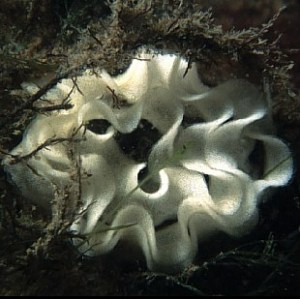
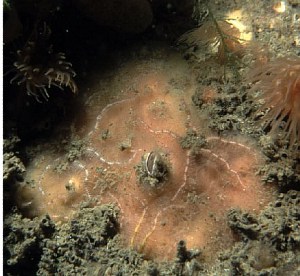
Dear Peter,
Thanks very much for the detailed information in this message and the accompanying one.
Best wishes,
Bill Rudman
Geitodoris planata - distinguishing features
August 22, 2001
From: Peter H. van Bragt
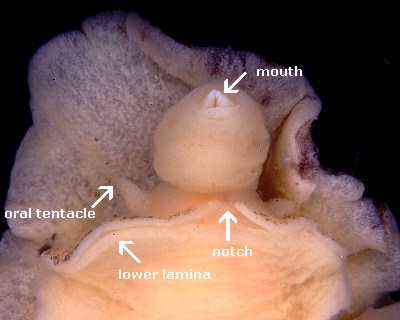
Dear Bill,
To accompany my earlier message, here are some photos to show particular characteristic features of Geitodoris planata. It has often been confused with Archidoris pseudoargus but it can be recognised in the field by the following features:
• The animal has large numbers of tubercles on the outer mantle, in various sizes and rounded in shape. There a small number of typical larger tubercles that are acid glands that most often appear in star shaped light coloured regions (see LOWER LEFT PHOTO).
• The underside of the mantle is lighter sandy brown in colour with at the edges typical darker brown small spots that often appear in pairs. (see LOWER RIGHT PHOTO). •It has a most characteristic pair of head tentacles that are rather difficult to observe in the field as they are hidden between the mantle and the foot at the underside of the animal. (see UPPER RIGHT PHOTO)
With best regards
Peter H. van Bragt
vanbragt.phjm@hsbrabant.nl
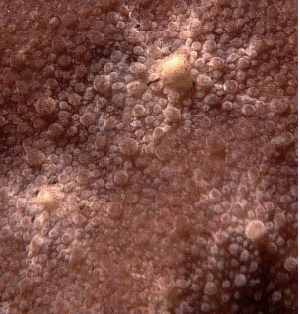
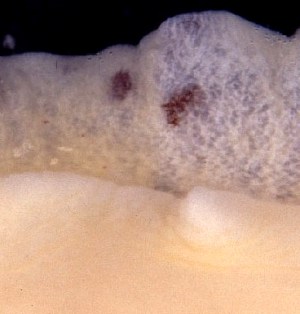
Dear Peter,
Thanks for these very useful photos, in particular the UPPER one which I have labelled. It is a ventral view of the front end of the body showing the head and anterior end of the foot. In this photo you can see:
• the mouth at the tip of a partly everted buccal bulb. I am not sure if this is 'natural' or whether the animal is dying as this bulb is normally only everted like this when the animal is feeding.
• the right oral tentacle. There will be another of these finger-like tentacles on the other side but it is obscured in the photo. Archidoris pseudoargus does not have finger-like tentacles like this so this is a good distinguishing character between the two species.
• the laminae on the anterior end of the foot. At the anterior end of the foot in many dorids you will find the edge is split into and upper and lower flap, which we call laminae. In Geitodoris the upper lamina is broken by a median notch. By comparison Archidoris doesn't have a notch.
Best wishes,
Bill Rudman
Is this Archidoris pseudoargus ?
June 13, 2001
From: Xavier Merlin
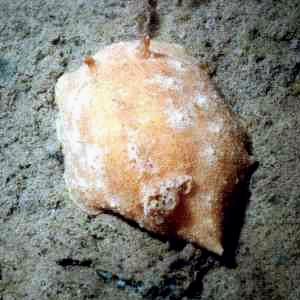
I have taken some pictures of what I believe to be a Sea Lemon (Archidoris pseudoargus). I see a lot of them now in the Oosterschelde in The Netherlands.
Is this indeed a Sea Lemon or is it another species?
Xavier
xavier.merlin@ping.be
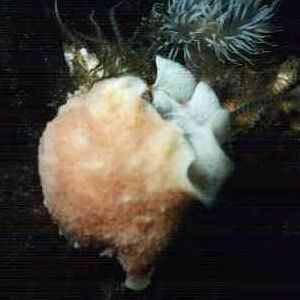
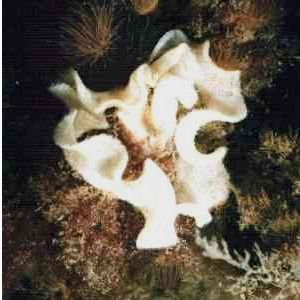
Dear Xavier,
I checked this with Bernard Picton who has just sent a number of photos to clarify the distinction between Archidoris pseudoargus and Geitodoris planata. He has also identified your animal as Geitodoris planata and says that Peter van Bragt's earlier record of Archidoris pseudoargus is actually another specimen of Geitodoris planata. If you look at Bernard's messages you will see the main distinguishing features of the two species. It is always possible that A. pseudoargus also occurs at the Oosterschelde, but up until now it seems I have inly been sent photos of Geitodoris.
Best wishes,
Bill Rudman
Identification of Geitodoris planata
June 13, 2001
From: Bernard Picton
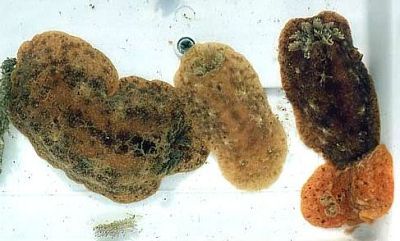
Hi Bill,
Here are pictures of Geitodoris planata for comparison with Archidoris pseudoargus. Its food is not known for certain but I suspect that it prefers to eat the sponge Mycale rotalis. The spawn coil has a more fluted edge than that of Archidoris pseudoargus. In my experience this is a scarce animal, normally only seen in ones and twos. I have sent photos of the acid glands, which form the typical stellate pattern on the mantle, and the spawn coil, in a separate message.
UPPER RIGHT: a tray of animals collected with Greg Brown in May 1976 - Rutland Channel, Burtonport, Co. Donegal, Ireland
LOWER LEFT: two animals - Garland Stone, Skomer, Wales - Jun 1989
LOWER RIGHT: Lough Hyne, Co. Cork, Ireland - 17 Mar 1990
Bernard
bernard.picton.um@nics.gov.uk
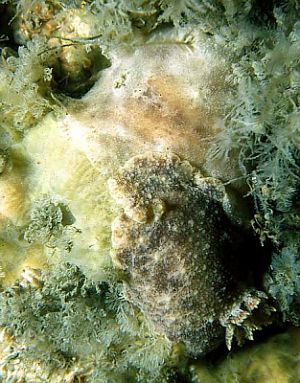
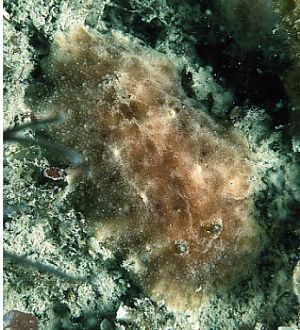
Thanks Bernard,
Your multiple photos of this species and Archidoris pseudoargus certainly give us, who are unfamiliar with the species, a better understanding of its variation.
Best wishes,
Bill Rudman
Geitodoris planata - acid glands, egg ribbon
June 13, 2001
From: Bernard Picton

Hi Bill,
Here are pictures showing the acid glands, which form a stellate [starlike] pattern on the mantle, and spawn coil of Geitodoris planata to accompany my other photos. The spawn coil has a more fluted edge than that of Archidoris pseudoargus.
UPPER & LOWER RIGHT: Showing starlike (stellate) pattern of mantle glands - Rathlin O'Birne Is., Co Donegal, Ireland - April 1982.
LOWER LEFT: Spawn coil - Garland Stone, Skomer, Wales - June 1989
Bernard
bernard.picton.um@nics.gov.uk
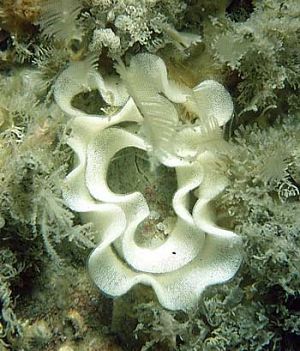
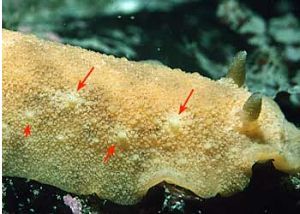
Thanks Bernard,
Bill Rudman.
Re: 'Dorid from France' is Geitodoris planata
August 27, 2000
From: Juan Lucas Cervera
Dear Bill,
When I return to the University I will try to send you a photo of Geitodoris planata to help in the discussion.
Regards.
Lucas.
lucas.cervera@uca.es
Cervera, J.L., 2000 (Aug 27) Re: 'Dorid from France' is Geitodoris planata. [Message in] Sea Slug Forum. Australian Museum, Sydney. Available from http://www.seaslugforum.net/find/2935Thanks Lucas,
Bill Rudman
'Dorid from France' is Geitodoris planata
August 26, 2000
From: Juan Lucas Cervera
Dear Bill,
I agree with the comments of Jussi. However, let me tell you that the correct name of the species "planata" is Geitodoris, not Discodoris. This was a mistake introduced by Tom Thompson (see Cervera, Garcia-Gomez and Garcia, 1985, published in J. Moll. Stud.).
Regards.
Lucas.
lucas.cervera@uca.es
Cervera, J.L., 2000 (Aug 26) 'Dorid from France' is Geitodoris planata. [Message in] Sea Slug Forum. Australian Museum, Sydney. Available from http://www.seaslugforum.net/find/2923Thanks Lucas,
I have moved it to a separate page. Some clearer photos of these larger "flat" dorids that you and your colleagues have reviewed in recent years would be useful additions to the Forum.
Best wishes,
Bill Rudman.
re: Dorid from France
August 23, 2000
From: Jussi Evertsen
Hi.
Archidoris pseudoargus has had many changes in the use of namegiving, as Angel Valdes has very clearly pointed out.
From northern waters Doris tuberculata is also a name mostly used by earlier workers. When Bergh (1878) created the genus Archidoris, Archidoris tuberculata was generally accepted until Eliot (1910) replaced the genus name with the older name Doris, in which he included other groups as Archidoris, Steurodoris and Platydoris. The use of Doris tuberculata therefore re-emerged until Iredale & O'Donoghue (1923) restored many of the older divisions, among them Archidoris; but this time under a new name Archidoris britannica.
From the pictures, the photo from Peter van Bragt might be Archidoris pseudoargus, but the photo from Erwin Koehler looks more like Discodoris planata. Discodoris planata can be distinguished from Archidoris pseudoargus by the stellate patterns on the mantle, and also by the more flattened shape (as he points out inthe text of the photo); but also by looking on the underside of the animal, Discodoris planata has brown spots on the mantle, and conspicous oral tentacles, both characters lacking in Archidoris pseudoargus. Not easy to see from a photo, but should not be to difficult to check out in the field by turning the animal upside down.
Yours sincerely
Jussi Evertsen
Trondhjem Biological Station
Norway
http://www.ntnu.no/~vmzotbak/nudibranchia
jussie@stud.ntnu.no
Evertsen, J., 2000 (Aug 23) re: Dorid from France. [Message in] Sea Slug Forum. Australian Museum, Sydney. Available from http://www.seaslugforum.net/find/2898Dear Jusssi,
I wondered whether Erwin's photo was of D. planata or is it Geitodoris planata?, but there are quite a number of similar looking 'flat dorids' described from the Atlantic coast of Europe and I doubt if a single photo is going to solve the problem.
I'll leave the photo where it is at present, not because I disagree with you, but until there seems to be a consensus on its identity. Otherwise I spend too much time correcting and changing filenames and links etc.
Best wishes,
Bill Rudman.
Dorid from France
August 7, 2000
From: Erwin Koehler

Dear Bill,
Here is the next one is from the Bassin d'Arcachon, south-west Atlantic coast
of France, close to Bordeaux. Size 40 mm, depth 5 m, nightdive on May 26, 1999.
The photos was taken by Michel Barrabés
Email: m.barrabes@libertysurf.fr
Michel writes that it looks more flat, circular and darker than Archidoris pseudoargus.
Erwin
Medslugs.Koehler@t-online.de
Koehler, E., 2000 (Aug 7) Dorid from France. [Message in] Sea Slug Forum. Australian Museum, Sydney. Available from http://www.seaslugforum.net/find/2851Dear Erwin,
This is another one for my Atlantic colleagues, who I am sure will be able to help.
Best wishes,
Bill Rudman
Archidoris pseudoargus from Holland
August 8, 1999
From: Peter H. van Bragt
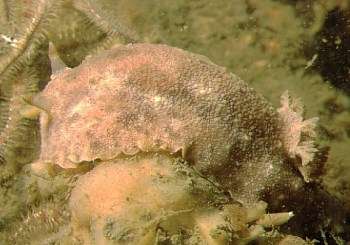
Note added 13 June 2001: This is Geitodoris planata. See Bernard Picton's message.
Dear Bill,
Here is a photo of Archidoris tuberculata to add to the Netherlands' List.
Location: : Zierikzee (Zeelandbrug), de Oosterschelde, the Netherlands
With best regards
Peter H. van Bragt
Peter.vanBragt@ftn.hsbrabant.nl
van Bragt, P.H., 1999 (Aug 8) Archidoris pseudoargus from Holland. [Message in] Sea Slug Forum. Australian Museum, Sydney. Available from http://www.seaslugforum.net/find/1169Dear Peter,
Thanks for the photo. Can someone help me out with an explanation on the use of the names
Archidoris tuberculata and Archidoris pseudoargus? Since Doris tuberculata Muller, 1778 is the earlier name, is its identity in doubt or is their an earlier use of the name Doris tuberculata for a different species?
Best wishes,
Bill Rudman.
